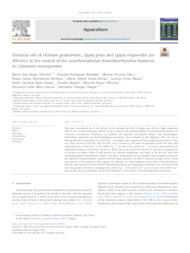Essential oils of Ocimum gratissimum, Lippia grata and Lippia origanoides are effective in the control of the acanthocephalan Neoechinorhynchus buttnerae in Colossoma macropomum.
Essential oils of Ocimum gratissimum, Lippia grata and Lippia origanoides are effective in the control of the acanthocephalan Neoechinorhynchus buttnerae in Colossoma macropomum.
Author(s): OLIVEIRA, M. I. B.; BRANDÃO, F. R.; TAVARES-DIAS, M.; BARBOSA, B. C. N.; ROCHA, M. J. S.; MATOS, L. V.; SOUZA, D. C. M.; MAJOLO, C.; OLIVEIRA, M. R. de; CHAVES, F. C. M.; CHAGAS, E. C.
Summary: This study investigated the in vivo efficacy of the essential oils (EOs) of Lippia grata (EOLG), Lippia origanoides (EOLO) and Ocimum gratissimum (EOOG) in the control of the acanthocephalan Neoechinorhynchus buttnerae in Colossoma macropomum (tambaqui). In addition, the parasitic and growth indices, and hematological, biochemical, enzymatic and histopathological parameters were evaluated in the tambaqui. After 30 days of feeding with diets containing 1.52 g EOLO kg−1, the length, mean weight and mean weight gain decreased. There was 100% survival of fish fed with the EOs, and a decrease in the rates of parasitism in fish fed with diets containing 0.86 g EOLG kg−1, 0.76 g EOLO kg−1, 1.03 and 2.06 g EOOG kg−1. For these concentrations, the anthelmintic efficacy of the EOLG was 62.1%, EOLO was 61.8% and EOOG was 58.7% and 59.8%, respectively. An increase in plasma levels of total protein and alkaline phosphatase was found in the fish fed with diets containing highest concentrations of EOLG and EOLO. Maintenance levels of alanine aminotransferase in plasma and aspartate aminotransferase, together with the higher frequency of mild to moderate damages in liver tissue and presence of focal point necrosis, suggest the influence of a high abundance of parasites on the biochemical and enzymatic processes of the host fish. Histomorphological and physiological indicators and a decrease in the rates of parasites with diets containing 0.86 g EOLG kg−1, 0.76 g EOLO kg−1 and 1.03 and 2.06 g EOOG kg−1 indicate that this is a promising therapeutic alternative in the control of acanthocephalosis in tambaqui.
Publication year: 2024
Types of publication: Journal article
Unit: Embrapa Amapá
Keywords: Efficacy, Eficácia, Fish farming, Fisiologia, Fisiologia Animal, Histopathology, Histopatologia, Peixe, Physiology, Piscicultura, Tambaqui
Observation
Some of Embrapa's publications are published as ePub files. To read them, use or download one of the following free software options to your computer or mobile device. Android: Google Play Books; IOS: iBooks; Windows and Linux: Calibre.
Access other publications
Access the Agricultural Research Database (BDPA) to consult Embrapa's full library collection and records.
Visit Embrapa Bookstore to purchase books and other publications sold by Embrapa.

